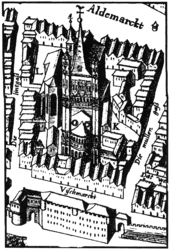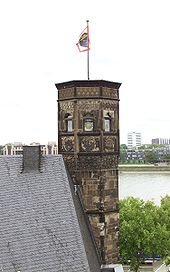Stack house
The Kölner Stapelhaus (kölsch Stapelhuus ), named after the Kölner Stapelrecht (from 1259), stands in front of the choir of the Church of Groß St. Martin . Today, the stacking house is a symbol of the trading metropolis Cologne, although little is known about its actual former function.
History of the market house
Already in the High Middle Ages there was a fish shop (Vischkouffhuis) serving the trade in sea fish in its place in the market district on the banks of the Rhine . Fish was an important food item on the Cologne diet, as it was considered cheap for people on a low income, and fish was allowed during Lent.
In the Middle Ages and the Late Middle Ages, Cologne was the main trading point for fish in the entire West, especially for sea fish (herring, stockfish, bucking fish, plaice). All goods had to be released in Cologne due to the stacking law (from 1259) for purchase and processing (especially for preserving fish). In the building, the fish were washed, cut up, cured, stored, repacked and given the Cologne brand, the three crowns , resold. Sewage pipes carried malodorous liquids directly into the Rhine.
In Cologne, fish was not only caught, prepared and sold for its own needs, but also fish wholesaling and shipping. Fish were sold wholesale in the fish department store , in the neighboring fish market and in the surrounding alleys in detail . In order to sell their fish, fish wholesalers came from far and wide to Cologne, including from the Netherlands, and the Cologne fishmongers for their part had customers as far as the Main area .
The traders called Fischmenger and Fischmengerssen were united in a guild and came from noble families. In Cologne - unlike in other cities - fish was »allowed« to trade for women, and the “Feschwiever” were also guild members (see Gaffel (Cologne) ). However, there were work restrictions: In 1397 the Fischmengersse were banned from selling larger fish that had to be weighed. (Most fish, however, were sold at unit prices.) In 1482 they were banned from trading in salted goods. They only had the small fresh (green) fish.
In 1425 the department store between Fischpforte and Mühlengasse was demolished and rebuilt. It was now also used for the taxation of other foods (butter, cheese, bacon, oil). Salt, flax, tar and other products were also for sale here.
From 1558 to 1561 the building was rebuilt again, now erected as the late-Gothic, fortified, crenellated building that is known from the panorama of the Rhine. The new structure was unusually long (side length approx. 46 m). With its eastern wall it formed part of the city wall; the representative half-timbered front faced the Rhine. In the now two-story building, merchants could rent lockable chambers (Stuvven) .
The stacking law remained in force until 1815; then the Congress of Vienna prohibited this practice of forced middlemen. In 1831, the compulsory handling was finally eliminated. In the second half of the 19th century (and the advent of the railroad) the storage rooms were therefore superfluous. 1900–1901, the city had the building rebuilt by city planning officer Friedrich Carl Heimann . It received its graceful stair tower, which is so characteristic today (also sometimes called knight tower or gender tower). In the basement there were now neat guest rooms and halls. Probably only now the name “Stapelhaus” was chosen.
From 1902 until its destruction, the Museum of Natural History was housed on the upper floor . It showed native and foreign groups of animals in biological representation .
In 1942 and again in 1944/45 the stacking house was destroyed by fire bombs, only the stair tower and remains on the south side remained. In the 1960s, instead of the splendid building that had been destroyed in the war, a simple replica with the hipped roof often found in Cologne was built. The floor plan was retained.
Todays use

Today's owner of the stacking house is the Cologne District Craftsmen's Association. From 1988 to 2013 the Federal Association of Visual Artists Cologne (BBK Cologne eV) was based in the Stapelhaus and organized exhibitions of regional and international artists in its rooms.
The Business Club Colonia Forum (eV), the “Club of Good Prospects”, is located on the fourth floor.
literature
- Adam Wrede : Neuer Kölnischer Sprachschatz , Vol. 3, Cologne 1999 (12th edition)
- Hans Vogts : The profane monuments of the city of Cologne , Düsseldorf, Schwann 1930, p. 308 ff.
- Bruno Kuske : The markets and department stores in medieval Cologne , in: JbKölnGV 2, 1913, pp. 75-133
- Hermann M. Wollschläger: Hanseatic City of Cologne. The history of a European trading metropolis , Cologne 1988
- Bruno Kuske: The Cologne fish trade from the 14th to 17th centuries , in: West German magazine for history and art 24, 1905, pp. 227-313
- Ernst Weyden : Cologne on the Rhine 150 years ago , Cologne, Bachem Verlag, 1960 (or Cologne around 1810)
- Irene Franken : Cologne. The women's city guide . Cologne 1995
Individual evidence
- ↑ for 1425 + 1561: Wrede: Sprachschatz , p. 121
- ↑ Traffic Office of the City of Cologne (ed.): Small guide through Cologne , Cologne, Kölner Verlagsanstalt, 1927, p. 44
Web links
Coordinates: 50 ° 56 ′ 20 " N , 6 ° 57 ′ 44" E




